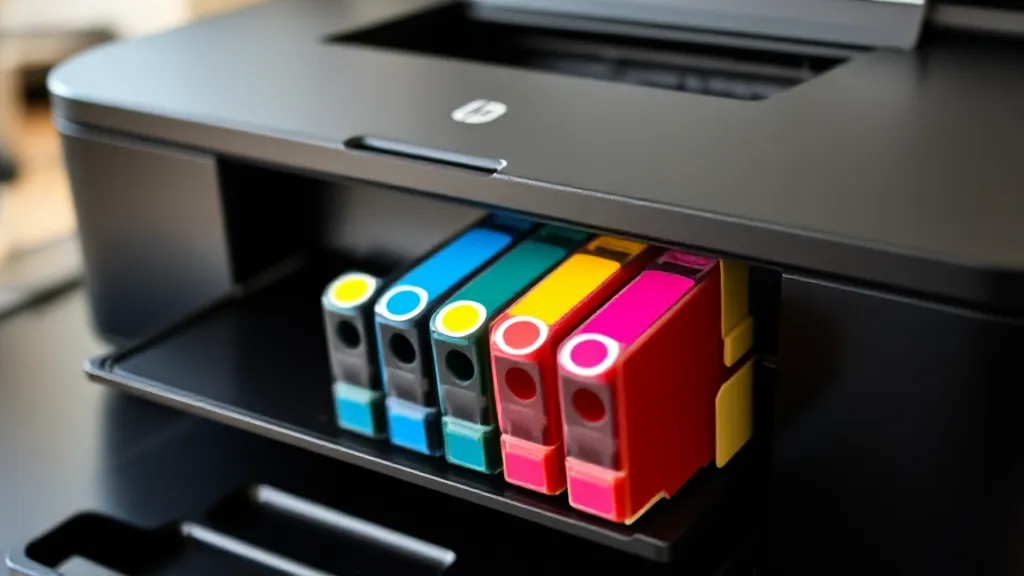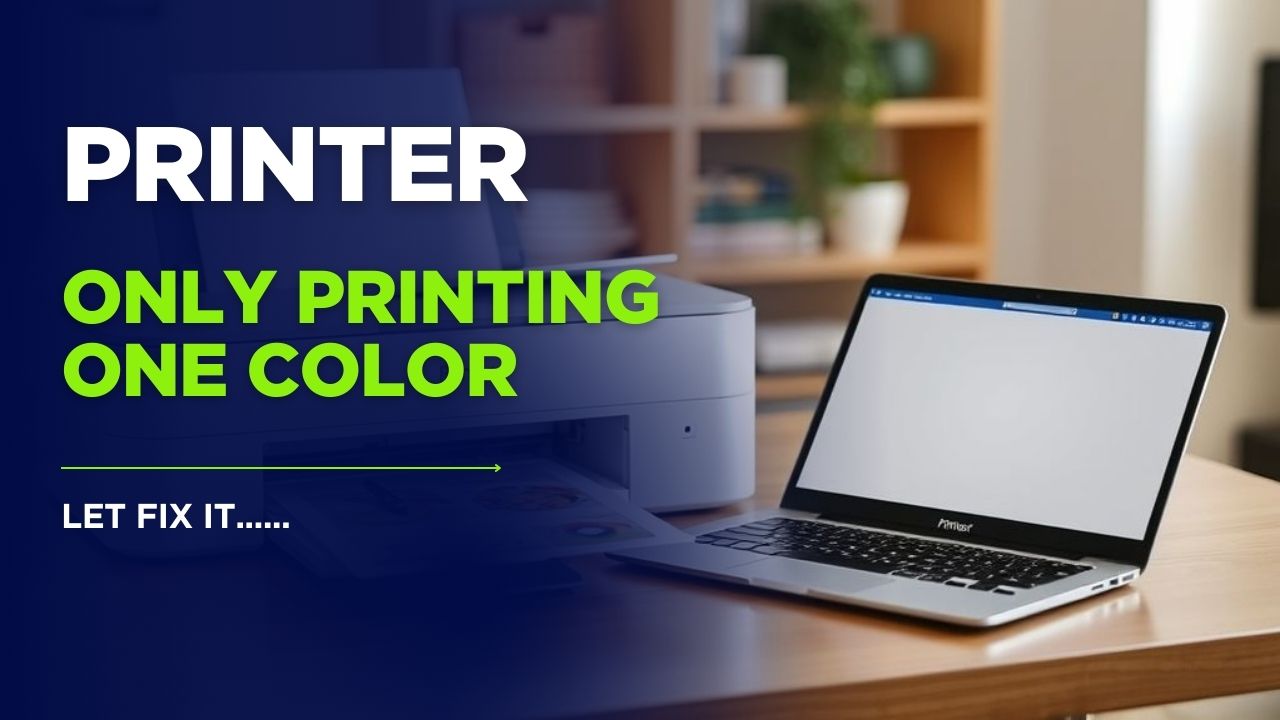Introduction
Is your printer only printing one color when you’re expecting vibrant, full-color documents or photos? This frustrating issue can disrupt your workflow and leave you with unusable printouts just when you need them most. Whether your printer is stubbornly outputting everything in cyan, black, magenta, or yellow—or refusing to print certain colors altogether—this comprehensive guide will help you diagnose and solve the problem. Color printing issues affect both inkjet and laser printers across all major brands, but fortunately, most can be resolved with the right troubleshooting approach. Follow our expert tips to restore your printer’s full-color capabilities and get back to producing the quality prints you need.
What Is Color Printing Technology?
Modern color printing relies on a sophisticated system that combines multiple ink or toner colors to create the full spectrum of hues we see in printed documents. Understanding this technology helps explain why your printer only printing one color is a sign of a specific type of malfunction.
Most consumer printers use one of two color systems:
CMYK (Cyan, Magenta, Yellow, Black): The standard for inkjet and laser printers, where these four base colors are layered or dotted in precise patterns to create all other colors. Each color resides in its own cartridge or tank in the printer.
RGB (Red, Green, Blue): While primarily used for digital displays, some specialized photo printers use variations of RGB technology, particularly those with expanded color gamuts that include light cyan, light magenta, and additional colors.
When your printer produces documents with only one color showing, it indicates a failure in part of this system. The issue might be mechanical (clogged print heads, misaligned cartridges), electronic (communication errors, driver problems), or supply-related (empty cartridges, incorrectly installed toner).
Color printing relies on precise dot patterns that blend to create the illusion of continuous color. When one component fails, the entire system becomes imbalanced, resulting in missing colors or documents printed entirely in a single hue. This understanding provides the foundation for the troubleshooting steps that follow.
7 Ways to Fix a Printer Only Printing One Color

1. Check Ink or Toner Levels
The most common reason for a printer only printing one color is simply that one or more of your ink or toner cartridges are empty. Here’s how to verify and address this:
For Inkjet Printers:
- Open your printer’s control panel on your computer
- Look for the ink level indicator (usually found in maintenance or tools section)
- Alternative method: On the printer itself, navigate through the menu to find ink levels
- Note which cartridges show as low or empty
- Replace any depleted cartridges with genuine or compatible replacements
For Laser Printers:
- Check toner levels through your printer’s display panel
- Some printers allow you to print a supply status page (look in reports or information menu)
- Replace any empty toner cartridges
- After replacement, run the printer’s calibration routine
Remember that some printers will refuse to print at all or will only print in black when color cartridges are empty, even if you’re trying to print a black-and-white document.
2. Run Print Head Cleaning Cycles
When a printer only printing one color issue occurs with inkjet printers, clogged print heads are often the culprit. Ink can dry in the tiny nozzles that deliver ink to the paper, blocking specific colors:
- Access your printer’s maintenance utility:
- On Windows: Go to Control Panel > Devices and Printers > right-click your printer > Printing Preferences > Maintenance tab
- On Mac: Go to System Preferences > Printers & Scanners > select your printer > Options & Supplies > Utility > Open Printer Utility
- Select “Head Cleaning” or “Clean Print Heads” option
- Follow the on-screen instructions to complete the cleaning cycle
- Print a test page to check if all colors are now printing
- If colors are still missing, run the cleaning cycle 2-3 more times
- Allow 30 minutes between cleaning cycles to prevent damage
For stubborn clogs, many printers offer a “Deep Cleaning” option, which uses more ink but is more effective for severe blockages. If multiple cleaning cycles don’t resolve the issue, continue to the next solutions.
3. Align Print Heads and Update Drivers
Misaligned print heads can cause color printing issues, while outdated drivers may cause communication problems between your computer and printer:
Print Head Alignment:
- Access your printer’s maintenance utility as described above
- Select “Print Head Alignment” or similar option
- Follow the on-screen instructions to print and scan an alignment page
- The printer will automatically adjust based on the scan results
Driver Updates:
- Visit the manufacturer’s website for your printer model
- Navigate to the support or downloads section
- Enter your printer model and operating system
- Download the latest printer driver package
- Uninstall your current printer driver before installing the new one:
- On Windows: Control Panel > Programs > Uninstall a Program > find your printer software
- On Mac: System Preferences > Printers & Scanners > select your printer > remove (-)
- Install the new driver package following the manufacturer’s instructions
- Restart your computer and test print a color document
4. Check Color Settings in Print Dialog
Sometimes the issue isn’t with the hardware but with the software settings. When facing a printer only printing one color problem, verify your print settings:
- Open the document you want to print
- Access the print dialog (usually File > Print)
- Look for “Properties,” “Preferences,” or “Advanced Options”
- Check the following settings:
- Ensure “Print in grayscale” or “Black and white” mode is NOT selected
- Verify “Color” mode is selected
- Check that any “Draft” or “Ink-saver” modes are disabled
- Look for color management settings and ensure they’re properly configured
- If printing from an image editor, check if the document itself is in CMYK or RGB mode
- In some applications, look for “Print all text as black” and disable it if you want colored text
Different applications have varying print dialog options, so explore all tabs and settings. Some advanced graphics programs like Adobe Photoshop have separate color management systems that can override your printer’s default settings.

5. Inspect and Clean Cartridge Contacts
Poor electrical connections between cartridges and your printer can cause a printer only printing one color issue. The small metal contacts on both the cartridge and the carriage inside the printer must be clean for proper communication:
- Turn off your printer and open the access door
- Remove all ink or toner cartridges carefully
- For inkjet printers, locate the copper or gold contacts on each cartridge
- Gently clean these contacts using a lint-free cloth slightly dampened with distilled water
- Also clean the corresponding contacts inside the printer carriage
- Allow contacts to dry completely (about 10 minutes)
- Reinsert each cartridge, ensuring they click firmly into place
- Close the printer and power it on
- Run a print test to check if colors are working
Avoid touching the print head nozzles on inkjet cartridges or the drum on toner cartridges. For laser printers, check that color toner cartridges are seated properly and any sealing tape has been completely removed.
6. Reset Your Printer
A simple reset can often resolve electronic glitches causing color printing problems:
Soft Reset:
- Turn off your printer using the power button
- Unplug the power cable from the electrical outlet
- Wait at least 60 seconds (this allows capacitors to discharge)
- Reconnect the power cable
- Turn the printer back on
- Try printing a test page with all colors
Factory Reset (use with caution as this will erase all settings):
- Access your printer’s control panel menu
- Look for “Reset,” “Restore Factory Settings,” or “Initialize Settings”
- Select the appropriate option to reset the printer
- Follow any on-screen prompts to complete the process
- Reconfigure any necessary network or preference settings
- Test print a color document
The exact steps for factory reset vary significantly between printer models, so consult your printer’s manual for specific instructions.
7. Check for Hardware Issues
If all software and supply-related troubleshooting fails when your printer only printing one color, you may have a hardware problem:
For Inkjet Printers:
- Inspect the ink tube system (for tank-based printers) for air bubbles or blockages
- Look for any physical damage to the print head assembly
- Check if the carriage moves freely across its track
- Listen for unusual noises during initialization that might indicate mechanical problems
For Laser Printers:
- Check for toner spills inside the printer that might block optical sensors
- Inspect the drum units for scratches or damage
- Verify that transfer belts are clean and undamaged
- Ensure all internal components are properly seated
For both types, consult your printer manual to locate key components. If you identify a damaged part, contact the manufacturer or a printer repair service. Hardware issues often require professional repair, especially for complex laser printers.

Additional Tools for Color Printing Problems
When troubleshooting a printer only printing one color situation, these additional tools and methods can help:
Manufacturer Diagnostic Software: Most major printer brands offer specialized diagnostic utilities beyond what’s available in standard driver packages. HP’s Print and Scan Doctor, Epson’s Diagnostic Tool, and Canon’s My Printer are examples that can automatically detect and fix common color issues.
Color Calibration Tools: For professionals requiring precise color matching, consider investing in a color calibration system like X-Rite i1Display Pro or Datacolor SpyderX. These create accurate ICC profiles that ensure what you see on screen matches your prints.
Print Head Cleaning Kits: For stubborn clogs that software cleaning cycles can’t fix, specialized cleaning kits with syringes and cleaning solution can be effective for manually cleaning print heads. These should be used carefully and as a last resort.
Third-Party Print Management Software: Applications like PrintFactory or ColorPort offer advanced color management features beyond what your printer’s default software provides, helping ensure consistent color reproduction.
Remember that precision color printing requires attention to the entire workflow—from monitor calibration to proper paper selection. Even a perfectly functioning printer will produce poor results if these other factors aren’t properly managed.
Common Color Printing Mistakes and Problems
Beyond the solutions already provided, being aware of these common mistakes can prevent many printer only printing one color problems:
Mixing Incompatible Cartridges
Using different brands or types of cartridges in the same printer can cause color inconsistencies. Some printers have chips that recognize non-original cartridges and may limit functionality as a result. Always use compatible cartridges from the same product line and, ideally, from the same production batch for the most consistent results.
Ignoring Paper Type Settings
Different papers absorb ink differently. Using photo paper but selecting plain paper in your settings (or vice versa) can result in oversaturated colors or faded prints. Always match your media type settings to the actual paper you’re using, particularly for photo printing where color accuracy is crucial.
Printing in Draft Mode
Draft or economy printing modes save ink but often do so by printing fewer color dots, resulting in washed-out colors or missing hues entirely. Check if you’ve accidentally left your printer in a draft or ink-saving mode when full-color output is needed.
Neglecting Environmental Factors
Extreme temperatures and humidity can affect ink viscosity and color mixing. Printers perform best in moderate environments (65-75°F, 40-60% humidity). A printer kept in a very cold garage or extremely humid basement may exhibit color printing issues even when everything else is correctly configured.
Ignoring Maintenance Schedules
Modern printers require regular maintenance beyond cleaning print heads. Many have internal cleaning cycles, pad replacements, or other service items that should be performed after printing a certain number of pages. Neglecting these can result in color problems. Check your printer manual for recommended maintenance schedules.
Frequently Asked Questions
Why is my printer only printing in one color when I’ve just replaced all cartridges?
New cartridges sometimes require initialization or priming before they work properly. Run a print head cleaning cycle to draw ink into the system. Also verify that you’ve completely removed all protective tape or plugs from new cartridges and that they’re properly seated in their slots.
Can software or document settings cause a printer to print in only one color?
Yes, absolutely. Check the print properties dialog for settings like “Print in grayscale” or “Black ink only.” Also examine the document itself—sometimes colors appear on screen but the actual document is set to use only one color in its formatting.
How do I know if my print head is permanently damaged?
If multiple deep cleaning cycles, manual cleaning attempts, and cartridge replacements don’t resolve the issue, your print head may be damaged. Signs include persistent streaking in the same position, missing lines of the same color across all prints, or error messages specifically mentioning the print head.
Is it worth fixing a printer with color issues, or should I replace it?
For expensive photo or office printers, repairs often make economic sense. For budget printers under $100, replacement is typically more cost-effective than repair. Consider the printer’s age, replacement part availability, and the cost of a service call versus a new printer with updated features and a fresh warranty.
Conclusion
When your printer only printing one color frustrates your printing needs, working methodically through these troubleshooting steps should resolve most issues. Start with the simplest solutions—checking ink levels and running cleaning cycles—before progressing to more complex fixes like driver updates or hardware inspections. Remember that regular maintenance is the best prevention against color printing problems. Clean your printer regularly, keep software updated, and use quality supplies appropriate for your printer model. If you’ve tried all the steps in this guide without success, it may be time to consult a professional technician or consider whether your printer has reached the end of its useful life. With proper care and the right approach to troubleshooting, you can enjoy vibrant, accurate color printing for all your documents and photos.
How to Add a Wireless Printer to Your Laptop Read More.





Recent Comments